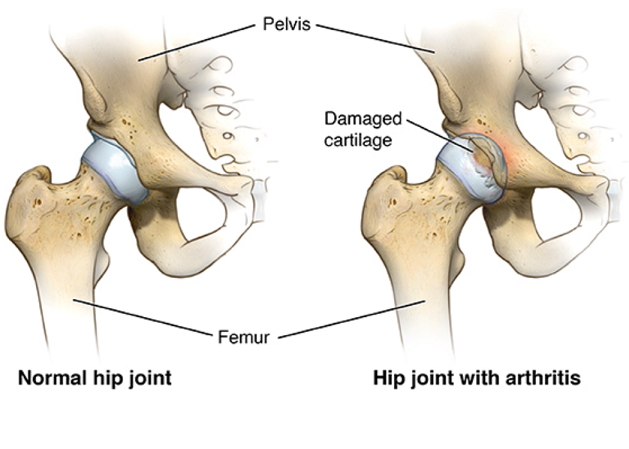What Is Osteoarthritis?
Osteoarthritis is a form of arthritis and a degenerative joint disease that causes the breakdown and eventual loss of joint cartilage. Cartilage is a protein substance that cushions the bones of a joint. With osteoarthritis, the top layer of cartilage breaks down and wears away. That breakdown allows bones under the cartilage to rub together, causing pain, swelling and disability.
The root cause of osteoarthritis is unknown. The risks associated with osteoarthritis can be influenced by your age, gender and inherited traits that affect the shape and stability of your joints. Other factors that can lead to osteoarthritis include:
- A previous joint injury
- Repetitive strain in one or more joints
- Improper joint alignment
- Being overweight
- Exercise or sports-generated stress placed on joints
Diagnosing Osteoarthritis
Many individuals who are affected by osteoarthritis share similar symptoms. Here are some of the more common symptoms that may indicate the presence of osteoarthritis:
- Pain while standing or walking short distances, climbing up or down stairs, or getting in and out of chairs
- Pain during activity
- Start up pain or stiffness when activities are initiated from a sitting position
- Stiffness in your knee or other joints after getting out of bed
- Swelling in one or more areas
- A grating sensation or crunching feeling when you use your knee
 Your physician will review your medical history and your symptoms. He or she will observe the natural movement of your knee, evaluate your joint alignments and check your reflexes. You will also be evaluated for muscle strength, range of motion and ligament stability in the affected area.
Your physician will review your medical history and your symptoms. He or she will observe the natural movement of your knee, evaluate your joint alignments and check your reflexes. You will also be evaluated for muscle strength, range of motion and ligament stability in the affected area.
Your physician may order one or more of the following diagnostic tests to determine how much cartilage has been lost, if bone spurs are present, or to pinpoint the exact location of the damage:
- X-rays
- Computed tomography (CT) scan
- Magnetic resonance imaging (MRI) scan
Your physician may also order blood tests to rule out other causes. A joint aspiration, which involves drawing fluid from the joint through and needle and examining the fluid under a microscope, is also sometimes needed.
How Is Osteoarthritis Treated?
Your Inova physician will most likely first recommend lifestyle changes to reduce stress on your joints. Some early forms of osteoarthritis can also be effectively treated with physical therapy, over-the-counter pain medications such as acetaminophen, steroid injections, nonsteroidal anti-inflammatory drugs (NSAIDS) or topical pain relieving creams.
If your symptoms do not respond to non-surgical solutions, you may be a candidate for surgery.
Total joint replacement is a common surgical intervention for individuals with advanced osteoarthritis who cannot manage their pain or instability through non-surgical means. During a joint replacement procedure, the natural joint is removed and replaced with an implant.
If you are living with osteoarthritis, Inova's Musculoskeletal services program can help. Our services include the full range of care in orthopedics, sports medicine, physical therapy (PT) and rehabilitation.